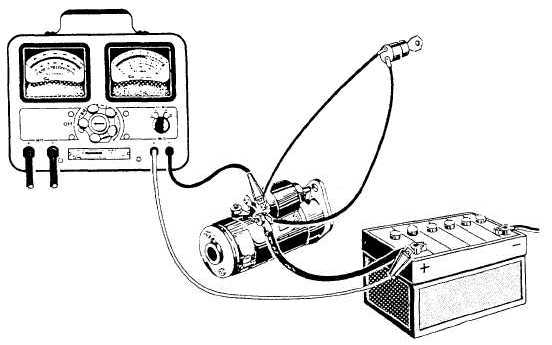specifications, this reading should not exceed a 0.2 volt loss. A reading of more than 0.2 volt loss usually indicates a loose, dirty or corroded connection, or ground cables that are too small to carry the current. To locate the point of excessive resistance, apply the voltmeter leads across each connection and cable, in turn, and take the readings with the starting motor in operation. These readings should not exceed 0.1 volt loss on short ground cables and should be zero across each connection. Long ground cables may have slightly more than 0.2 volt loss.
SOLENOID SWITCH CIRCUIT RESISTANCE TEST
High resistance in the solenoid switch circuit reduces the current flow through the solenoid windings and causes the solenoid to function improperly or not at all. Improper action of the solenoid switch, in most cases, results in burning of the main switch contacts which reduces current flow in the starter motor circuit.
To conduct the solenoid switch circuit resistance test on a 6-, 12- or 24-volt series system, perform the following:
Connect the VOLTMETER leads of the tester, as shown in figure 4-27, and observe the polarity as you make the connections. Be sure the voltmeter lead clip at the solenoid contacts the switch terminal-not the solenoid wire end. Now, turn the voltmeter selector switch to the No. 4 VOLT position. Before cranking the engine with the ignition switch ON, connect a jumper lead from the secondary terminal of the coil to ground to prevent the engine from starting during the test. While cranking the engine, observe the voltmeter reading. This reading, unless otherwise specified by the manufacturer's specifications, should not exceed a 0.5 volt loss. A reading of more than a 0.5 volt loss usually indicates excessive resistance. However, on certain vehicles, experience may show that a slightly higher voltage loss is normal. To isolate the point of high resistance, apply the voltmeter leads across each part of the circuit, in turn, taking readings with the starting motor in operation. A reading of more than 0.1 volt loss across any one wire or switch usually indicates trouble. If high readings are obtained across the neutral safety switch used on automatic transmission equipped vehicles, check the adjustments of the switch as outlined in the manufacturer's manual. Make sure all vehicle wires disconnected during the tests are reconnected securely and properly at the conclusion of the tests.
IGNITION SYSTEMS
The treatment of ignition systems given in Construction Mechanic 3 & 2, NAVEDTRA 10644, mainly deals with the operating principles of a conventional automotive ignition system. The treatment

Figure 4-27.-Solenoid switch circuit resistance test.
Continue Reading